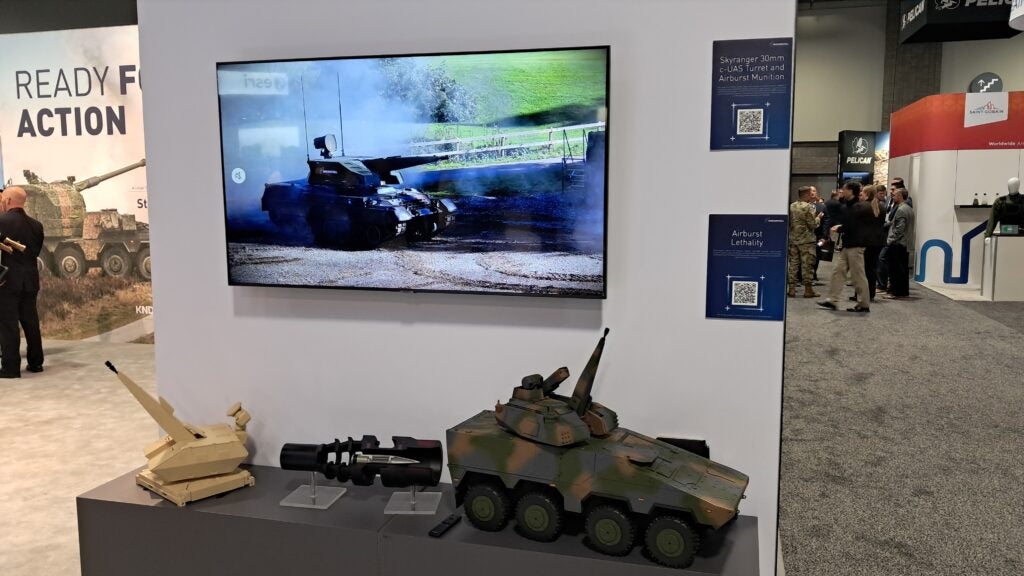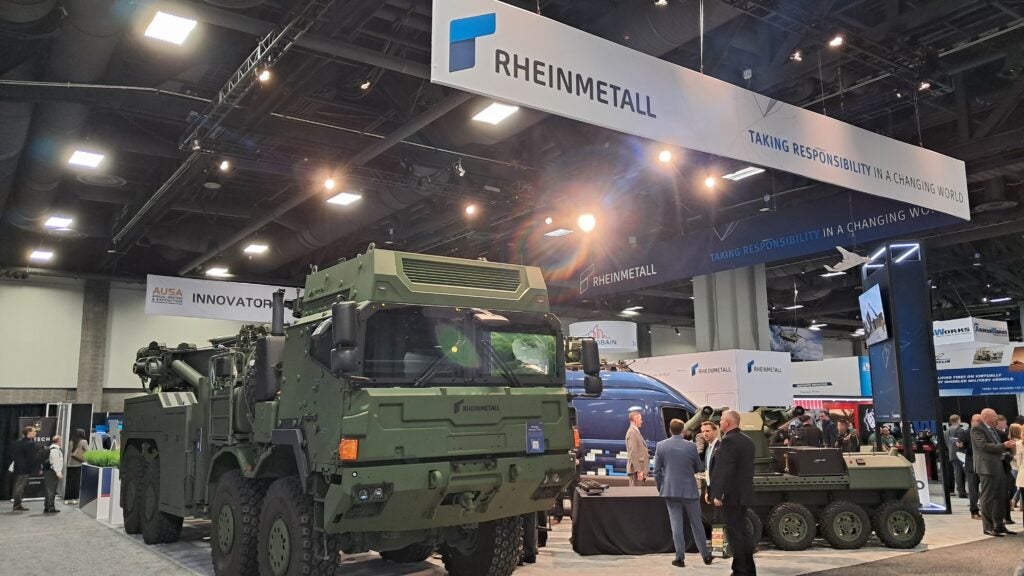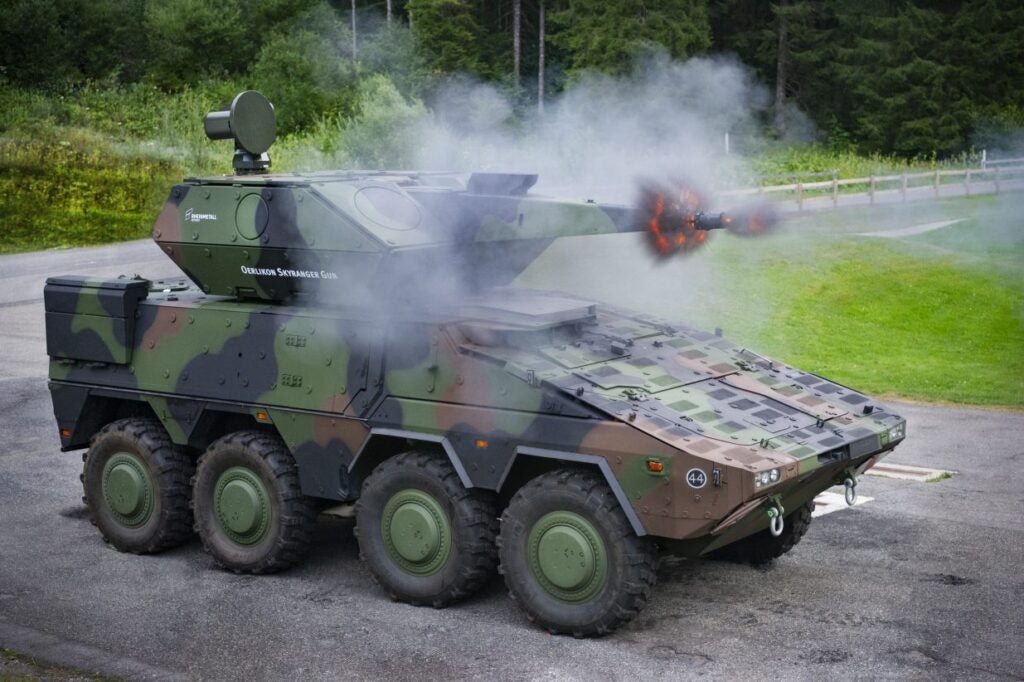AUSA 2024: Rheinmetall’s Skyranger 30 Takes on Drones
In a world where drones are omni-present, shooting them out of the sky is an ever-present concern. And, with how cheap drones can be compared to many modern air defense systems, economy of force is becoming a serious consideration for CUAS (Counter Unmanned Aerial Vehicle Systems) solutions. At AUSA 2024, Rheinmetall presented their latest answer to drones- the Skyranger 30 turret protype.
“The basic characteristics is this weapon system consists of a 30 millimeter revolver cannon and laser rangefinder, electro-optical tracking system and, of course, a radar to acquire the targets in the sky,” Rheinmetall Vice President of Marketing and Sales – Air Defence and Radar Systems, Gerson Jaklin told Overt Defense. “But the key for the success of the anti-drone application is our unique AHEAD ammunition.”

These rounds detonate near the drone releasing a large amount of cylindrical tungsten pellets like buckshot, effectively guaranteeing at least one will hit and bring the drone down.
“This round is not using any explosives, but the effect on the target is pure kinetic energy. […] A small ejection charge opens the projectile and releases tungsten subprojectiles, very heavy metal subprojectiles, in front of the target, and we always fire a burst. So we create a very dense cloud of heavy metal in front of the target and not even the smallest target can fly through that without being hit multiple times. And this is the key for counter drone engagement. We can engage any drone, from micro drones up to class whatever, with these systems.”
To engage a drone, a burst of less than 10 rounds is completely sufficient, making the system economical compared to missile-based AA.
“It depends on the size of the drone, but our experience says, if you fire a burst of nine rounds, in more than 80% of the cases, you will hit with the first three rounds. The other ones are just a backup. When you engage a small drone, you are maybe engaging around 1,000, 1,500 meters, and depending on the speed of the target, you might only have one chance to engage and this is why we have reverse legs like that.”
The cannon fires at a rate of 1,250 rounds per minute, meaning those nine rounds would all be up in the air within half a second. As the rounds travel between magnetic coils, the muzzle velocity of each projectile is measured. A computer then calculates at which exact moment the rounds should burst to achieve a hit, and they are programmed accordingly.
Overt Defense also asked Jaklin about how well the system can handle simultaneous attacks from multiple drones.
“Due to the fact that you only have one tracking channel, normally you can engage one target at a time, but we had a test in our valley in Switzerland three years ago demonstrating we can also engage a drone swarm. In this case, we launched a drone swarm of eight drones. The radar determines all the single targets and says ‘okay, this is a swarm’. What we then do is our fire control system, our C2 system, calculates the ‘center of gravity’ in the middle of the swarm where we engage with the burst. Due to the dispersion and the sub-projectiles, you engage the whole swarm with one burst. If the swarm is bigger, you can do sub-swarm, so to say. So this system is able to even counter saturation attacks.”

It is also important to remember that the system would likely be working as part of a larger air defense network.
“Skyranger itself is still able to operate autonomously, but the operational concept is many vehicles that are connected, or you can even have a control node that is controlling several vehicles at a time and do some fire distribution.”
However, the exact way and quantity in which the system would be employed is a question of military doctrine. “It all depends on the operational concept of each customer,” Jaklin added. “If you have a mechanized brigade, we foresee maybe five to ten of these vehicles”.
The system is just leaving the protype stage and beginning production with a number of countries putting in orders in 2023 and 2024. Germany ordered 19 systems mounted on a Boxer AFV, Austria ordered 36 mounted on the Pandur EVO (with an option for 9 more), and Denmark ordered 16 mounted on the Mowag Piranha V. Unconfirmed reports indicate Hungary will soon join the list, and the system is also being considered in Lithuania and the US. Moreover, there are other options including a 35mm cannon variant and stationary turrets.
“We were just talking about the mobile version now, but we also have a stationary version, of course, which is called the Skynex system. This is the effector of the system. So we have several effectors employed to one system. We have a multi-sensor unit, the heart and the brain of the system, and then it’s a technical level control node which is controlling the entire system. The caliber is a little bit different, 35mm, but the principle, as I explained to you, is pretty much the same.”
According to an official Rheinmetall release, the 30mm gun is effective at 3,000 meters and the 35mm variant can engage targets 4,000 meters away. The system can be integrated with a large variety of sensors, and the company is exploring integration of high-energy lasers and missiles with the systems.

